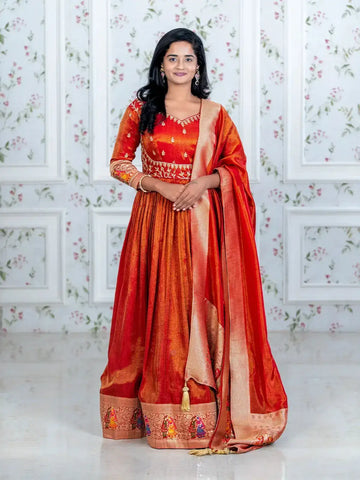
A Brief History of the Western Bridal Gown: From Royalty to Runway
When you picture a Western bride, chances are you imagine a white gown — flowing fabric, perhaps lace, maybe a veil — a vision of elegance. But where did this bridal archetype begin? The Western bridal gown as we know it has evolved dramatically over centuries, shaped by politics, fashion revolutions, celebrity influence, and cultural shifts. This blog takes you through the fascinating journey of the wedding dress — from royal courts to modern runways.
The Medieval Era: Symbolism Over Style
In early Western history, weddings were more about political alliances and family wealth than personal choice. Brides wore their most luxurious garments, from silk to velvet, in rich tones like burgundy and green. These outfits weren't always white — they were statements of status.
Fast forward to today, the focus on regal flair and luxurious detail continues, especially in modern bridesmaid gowns and designer bridal outfits that nod to this history while embracing personal expression.
1840: Queen Victoria and the Birth of the White Gown
The iconic white wedding dress became a trendsetter thanks to Queen Victoria, who wore a white satin gown at her wedding to Prince Albert. Her look popularized the color as a symbol of purity and elegance, setting the tone for bridal fashion across Europe and beyond.
Today, many of these classic silhouettes and details are reinterpreted in gowns available through modern online boutiques like Diadem Store, where heritage meets fashion-forward design.
Early 1900s: Grace and Grandeur
With Edwardian fashion came long trains, corsets, lace sleeves, and layers. The emphasis was on modesty and romanticism. Brides embodied poise and restraint — an aesthetic that’s still found in modern vintage-inspired gowns.
From bridal trousseaus to coordinated bridesmaid gowns, the early 20th century shaped the ceremonial importance of attire.
The Roaring Twenties to the Fifties: The Golden Age
Flapper brides in the 1920s embraced shorter hemlines, beaded details, and drop waists. By contrast, the 1950s saw a revival of opulence with voluminous skirts and ultra-feminine tailoring, inspired by Christian Dior’s “New Look.”
Today’s brides often draw from this golden age for inspiration, choosing sleek or retro-style bridal and bridesmaid dresses that blend comfort with timeless flair.
1960s–1990s: Rebellion and Reinvention
The counterculture movement brought unconventional hemlines, bold accessories, and a rejection of rigid traditions. From hippie-inspired gowns to Princess Diana’s unforgettable puffed sleeves in the ‘80s, bridal fashion became a canvas for personality.
These decades paved the way for modern freedom of choice — something reflected in Diadem’s range of bridesmaid gowns that cater to every mood and aesthetic.
The 21st Century: Your Gown, Your Way
From minimalist satin to bold hues, and even fusion gowns blending Indian and Western styles — today’s bride is in full control. Online platforms like Diadem Store offer an inclusive range of bridal and bridesmaid collections that celebrate every identity and body type.
Whether you're inspired by royal tradition or contemporary trends, today's bridal look is less about rules and more about storytelling.
Conclusion: A Dress That Evolves With You
The Western bridal gown has journeyed from a symbol of status to an icon of self-expression. Whether you're wearing a dramatic gown, a tailored jumpsuit, or a coordinated bridesmaid ensemble, your outfit tells a story — your story.
Explore Diadem’s curated bridesmaid gown collection or shop timeless bridal styles at DiademStore.com — where elegance and individuality go hand in hand.

